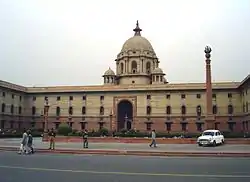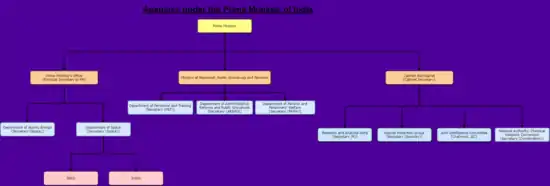Cabinet Secretariat (India)
The Cabinet Secretariat (IAST: Mantrimanḍala Sacivālaya) is responsible for the administration of the Government of India. It functions from the Secretariat Building, New Delhi, where most of the Cabinet of India sits. It comprises a set of two buildings on opposite sides of Rajpath which are home to some of the most important ministries of the Government of India, situated on Raisina Hill, New Delhi, India.
| Mantrimanḍala Sacivālaya | |
 | |
 South Block building, housing the Cabinet Secretariat | |
| Secretariat overview | |
|---|---|
| Preceding Secretariat |
|
| Jurisdiction | |
| Headquarters | Cabinet Secretariat Raisina Hill, New Delhi 28°36′54″N 77°12′21″E |
| Employees | 921[1] (2016 est.) |
| Annual budget | ₹1,140.38 crore (US$160 million)(2020–21 est.)[2] |
| Minister responsible | |
| Secretariat executive | |
| Child agencies | |
| Website | https://cabsec.gov.in/ |

Overview

The Cabinet Secretariat is responsible for the administration of the Government of India (Transaction of Business) Rules, 1961 and the Government of India (Allocation of Business) Rules 1961, facilitating a smooth transaction of business in Ministries/ Departments of the Government by ensuring adherence to these rules. The Secretariat assists in decision-making in Government by ensuring Inter-Ministerial coordination, ironing out differences amongst Ministries/ Departments and evolving consensus through the instrumentality of the standing/ad hoc Committees of Secretaries. Through this mechanism new policy initiatives are also promoted.
The Secretariat Building houses the following ministries:
- Ministry of Defence (MoD)
- Ministry of Finance (MoF)
- Ministry of External Affairs (MEA)
- Ministry of Home Affairs (MHA)
- Prime Minister's Office (PMO)
The Secretariat Building consists of two buildings: the North Block and the South Block. Both the buildings flank the Rashtrapati Bhavan.
- The South Block houses the PMO, MoD and the MEA.
- The North Block primarily houses the MoF and the MHA.
The terms 'North Block' and 'South Block' are often used to refer to the MoF and the MEA respectively.
The Secretariat Building was designed by the prominent British architect Herbert Baker. The building adopts elements from Rajputana styles of architecture. Examples include the use of Jali – decorated to protect from the scorching sun and monsoon rains of India. Another feature of the building is a dome-like structure known as the Chatri, a design unique to India, used in ancient times to give relief to travellers by providing shade from the hot Indian sun.
The style of architecture used in Secretariat Building is unique to Raisina Hill.
Organization
Cabinet Secretariat has three wings: Civil, Military and Intelligence. Under the Cabinet Secretary, there are several secretaries heading various departments, e.g., Secretary (Coordination) (heads the Department of Cabinet Affairs) (also holds the post of Chairman of National Authority for Chemical Weapons Convention), Secretary (Security) (under whom comes the Special Protection Group) and Secretary (R) (heads Research and Analysis Wing; ex-officio Director General of Security, under whom are the Aviation Research Centre and the Special Frontier Force). The Directorate of Public Grievances is also under the Cabinet Secretariat.
Cabinet Secretary
The Cabinet Secretary is the ex-officio head of the Civil Services Board, the Cabinet Secretariat, the Indian Administrative Service (IAS) and head of all civil services under the rules of business of the Government.
The Cabinet Secretary is generally the senior-most officer of the Indian Administrative Service. The Cabinet Secretary ranks 11th on the Indian Order of Precedence.[3][4][5][6] The Cabinet Secretary is under the direct charge of the Prime Minister. Though there is no fixed tenure, the office-bearer's tenure can be extended.
Before the adoption of the portfolio system in the Government of India, all governmental business was disposed of by the Governor-General-in Council (earlier name of Cabinet Secretariat), the Council functioning as a joint consultative board. As the amount and complexity of business of the Government increased, the work of the various departments was distributed amongst the members of the Council: only the more important cases were dealt with by the Governor-General or the Council collectively.
This procedure was legalised by the Councils Act of 1861, during the time of Lord Canning, leading to the introduction of the portfolio system and the inception of the Executive Council of the Governor-General. The Secretariat of the Executive Council was headed by the Cabinet Secretary.
The constitution of the Interim Government in September 1946 brought a change in the name, though little in functions, of this Office. The Executive Council's Secretariat was then designated as the Cabinet Secretariat. It seems, however, at least in retrospect, that Independence brought some change in the functions of the Cabinet Secretariat. It no longer remained concerned with only the passive work of circulating papers to Ministers and Ministries, but instead developed into an organisation for effecting coordination between the Ministries.
Prime Minister
The Cabinet Secretariat is under the direct charge of the Prime Minister. When any policy is made in the Cabinet Secretariat there must be signature of Prime Minister and Cabinet Secretary of India. The Prime Minister of India is the Head of the Union (Federal) Government, as distinct from the President of India, who is the Head of State. Since India has parliamentary system of constitutional democracy, it is the Prime Minister who oversees the day-to-day functioning of the Union Government of India.
The Prime Minister is assisted in this task by his Council of Ministers, comprising Cabinet Ministers, Ministers of State with Independent Charge, Ministers of State who work with Cabinet Ministers, and Deputy Ministers.
Project Monitoring Group
In June 2013, a cell within the Cabinet Secretariat called the Project Monitoring Group was created to track stalled investment projects, both in the public and private sectors and to remove the implementation bottlenecks in these projects on a fast-track basis.[7] An online portal open to the public was created where projects worth over ₹1,000 crore (US$140 million) were to be tracked.[7]
The Project Monitoring Group was moved to the Prime Minister's Office in 2014.[8][9]
Important officers
| Name, Service | Designation/ Rank |
|---|---|
| Rajiv Gauba, IAS | Cabinet Secretary |
| Dr. V. P. Joy, IAS | Secretary |
| Rachna Shah, IAS | Additional Secretary |
| Anuradha Thakur, IAS | Joint Secretary |
| Dr. Amandeep Garg, IAS | Joint Secretary |
| Sandeep Sarkar, IDAS | Joint Secretary |
| Ashutosh Jindal, IAS | Joint Secretary |
| Bharat H. Khera, IAS | Joint Secretary |
| Pankaj Agarwal, IAS | Joint Secretary |
See also
Notes
References
- Thakur, Pradeep (2 March 2017). "Central govt to hire 2.8 lakh more staff, police, I-T & customs to get lion's share". The Times of India. New Delhi. Retrieved 14 January 2018.
- "Ministry of Home Affairs – Cabinet Secretariat Budget 2020-21" (PDF). www.indiabudget.gov.in. Retrieved 1 August 2020.
- "Order of Precedence" (PDF). Rajya Sabha. President's Secretariat. 26 July 1979. Archived from the original (PDF) on 29 September 2010. Retrieved 24 September 2017.
- "Table of Precedence" (PDF). Ministry of Home Affairs, Government of India. President's Secretariat. 26 July 1979. Archived from the original (PDF) on 27 May 2014. Retrieved 24 September 2017.
- "Table of Precedence". Ministry of Home Affairs, Government of India. President's Secretariat. Archived from the original on 28 April 2014. Retrieved 24 September 2017.
- Maheshwari, S.R. (2000). Indian Administration (6th ed.). New Delhi: Orient Blackswan Private Ltd. ISBN 9788125019886.
- "Prime Minister sets up a Project Monitoring Group to Track Large Investment Projects". Press Information Bureau of India. 13 June 2013. Archived from the original on 2 March 2011. Retrieved 18 January 2018.
- Makkar, Sahil (28 December 2014). "Monitoring group under PMO to push 225 pending big-ticket projects worth Rs 13 lakh cr". Business Standard. New Delhi. Retrieved 18 January 2018.
- Nair, Rupam Jain; Das, Krishna N. (18 December 2014). Chalmers, John; Birsel, Robert (eds.). "India's Modi moves in to speed up $300 billion stuck projects". Reuters. New Delhi. Retrieved 18 January 2018.
- "Cabinet Secretariat, Government of India". cabsec.gov.in. Retrieved 1 August 2020.